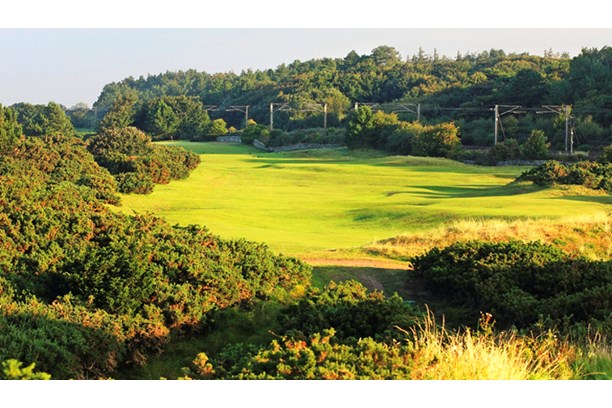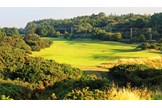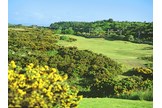Royal Troon, Old Course
Last updated:
What we say
Often overlooked, Royal Troon boasts some of the most scenic golf of any course on the Open rota.
Tam Arte Quam Mart – as much by skill as by strength. It seems an appropriate motto for Royal Troon, a club whose course incorporates the shortest hole on The Open rota.
Yet Royal Troon is not all it seems. It does have the shortest hole yet also for a while possessed the longest (and may do so again). And while its front nine can be a birdie-fest for Tour pros, not even the elite relish the relentlessly arduous inward half. It is accused of being flat and bland, yet for much of the front nine the views surpass most among Open venues.
The truth is, it’s very easy to get Troon wrong. It may lack the obvious visual appeal of Turnberry but neither is it anything like as enclosed as, say, Royal Lytham or Carnoustie; it does in fact, offer much more in the way of sea views than most on the Open rota. Stand on the championship tee of the 1st and you are afforded views of the Isle of Arran across the Firth of Clyde and, on a clear day, Ailsa Craig. There is no opening shot on an Open course with a more expansive panorama, a suggestion that may surprise given Troon’s reputation for dour solidity.
RELATED: Golf World Top 100 Courses in Scotland
While it lacks the eccentricities that infuse such character into the Old Course and entertainment into neighbouring Prestwick, Troon has holes that tumble over and through some of the most striking linksland of any Open venue.
And of Open hosts past and present it is home to a hole second only to the 17th on the Old in worldwide renown.
‘The Postage Stamp’ sniggers with disdain at the 240-yard one-shotters that fail to trouble today’s Tour pros and eloquently dismisses the notion that the only way to protect a short hole from Rory et al is to require them to unsheath a wood and/or surround it with water.
Troon’s 8th often requires the shortest club in your satchel, and there is not so much as a puddle around the green, yet it likely played on the mind of the field more than most other holes when it staged the 2016 Open and will do so again when it is next selected to play host.
Because miss the target and so penal are the slopes and bunkers surrounding the tiny surface that the escape route to par is never straightforward.
Adding to the affection – and the challenge – of this iconic hole is the wonderful view from the tee, perched high overlooking the linksland and the sea and as a result catching the breeze. Adapting to the wind on the 8th is more tricky as it is the only outward hole that does not play into the prevailing south-westerly. It means the opening holes – a trio all under 400 yards, resulting in a shorter front nine by nearly 300 yards – play longer than the drive and wedge they might suggest to the strong player.
GOLF COURSE REVIEW: Trump Turnberry (Ailsa Course)
In turn, the wind should be at your back on every hole as you tackle an inward half where every par 4 is over 430 yards.
It’s why players can go out in 10 fewer shots than they come back in, or more – and Martin Ebert of the R&A’s preferred architects, Mackenzie & Ebert, likes the differing phases of Troon.
“People ask ‘what have you done to the first three holes’, because they are deemed weak,” Ebert tells GW. “But every course has a different rhythm and you need to make the score on the front nine here.
“In general I think Troon is underrated. I find it strange it is ranked almost lowest of the Open venues. Scenically it is strong in a lot of spots. Of course, there aren’t many weak Open courses…”
Troon does not lack for pedigree either, being formed in 1878 at a meeting of enthusiasts in the town’s Portland Arms Hotel, which lends its name to the terrific ‘second’ course here (initially known as the Troon Relief Course, it opened in 1895 before Alister MacKenzie redesigned it in 1920) whose inclusion in the steep championship green fee makes the price much more digestible.
Six holes were laid out by Prestwick pro Charles Walker the following year before George Strath was appointed Troon’s first pro in 1882. Strath was instrumental in the growth of the links to 12 and then, by 1888, to 18 holes and his successor Willie Fernie (there have been only four other pros since) refined the layout further when he took up residence.
Troon, which attained ‘Royal’ status in its Centenary Year, is often criticised for its stance towards ladies yet the British Ladies’ Amateur was welcomed in 1904 and within 20 years The Open followed.
GOLF COURSE REVIEW: Dundonald Links
That 1923 championship witnessed Britain’s sole Troon Open champion, Arthur Havers, and he was followed in 1950 by Bobby Locke. Since then, though, the champions all hailed from the US before Henrik Stenson’s epic triumph, Troon’s links almost paying homage to Arnold Palmer for his part in re-popularising The Open among his countrymen in time for his epochal 1962 victory here.
Since then the baton has passed to Tom Weiskopf, Tom Watson, Mark Calcavecchia, Justin Leonard and finally Todd Hamilton.
Returning champions in 2016 found only minor changes to the links they won on.
The 1st is one of eight holes to have larger tees but otherwise the questions the opening trio ask remain the same. And while the challenge is relatively mild and there is a relative lack of variety, these are hardly weak holes. Then comes a friendly par 5 followed by the first par 3 alongside the beach whose sea views have been opened up by the removal of a large rose bush that had been blocking the view.
Another par 5 arrives at the 6th, whose views have also been opened up by buckthorn removal from behind the green. “Andrew Cotter, who’s from Troon, then asked why we didn’t just push the green back towards the beach,” reveals Ebert. “We thought, ‘why didn’t we think of that?’ It is on the agenda…”
That clearance work also enhances the terrific view from the 7th, the exotically-named ‘Tel-el-Kebir’. One of Troon’s highlights, this dog-leg offers an inviting elevated drive round a dune for faders, then a tight approach. An old bunker has been reintroduced to add penalty for those having a cut at the green.
GOLF COURSE REVIEW: Western Gailes
After the famous 8th, the 9th begins with the first of four blind drives in a row and ends on a green with a new dune beyond it to add discretion between the links and the caravan park yet without adding shade from trees. Gorse on this artificial bank helps blend in.
Turning round, you hope your score is made as you eye up MacKenzie’s only input on an Open course – a gaping bunker in the sand ridge over which you drive on 10. As on the following hole, a new championship tee adds length (up to 438 yards) and changes the angle.
Even with a breeze kissing your back as you stand here, home feels a long way away; the same emotion one had as a child at the bottom of a very good (and by definition long and steep) sledge run.
The fun has been had, now the graft begins. Instead of a snow-covered hill, the scene here is of gorse, sand and rough.
GOLF COURSE REVIEW: Gailes Links
The 11th is no less intimidating, the railway hard to the right and a blanket of gorse in front. It is possible a train will thunder past and a plane climb into the clouds from Prestwick as you attempt to find the fairway. More stringent par 4s follow, broken only by the modest short 14th before a classic 5-3-4 finish.
A burn bisects the 16th fairway at 280 yards yet at the 2004 Open some players were nearly carrying it. With re-routing the burn deemed too drastic, undulation has been added to the right to add risk to the reward.
The ‘table top’ green of the par-3 17th is awkward to hit and into the wind is a beast. But the home hole is relatively placid and by the time July arrives, the approach bunkering may be reconfigured to add challenge. Even so, most interest here is in the out of bounds path a few steps off the back of the green, hard to the steps of the clubhouse.
Royal Troon hides little surprises right to the end. You may have heard it is ‘six dull holes, six exciting holes, six dull holes’. The truth is far from that.
RELATED: Golf World Top 100 Links Courses in Great Britain and Ireland
-
Course Summary
- Costs -
- TG Rating
- Players Rating
- Address 2 Craigend Road, , TROON
- Tel 01292 311555
- Website www.royaltroon.co.uk
Course Information
| Course | 71 par |
| Course Style | - |
| Green Fees | - |
| Course Length | 7,208 yards (6,591 metres) |
| Holes | - |
| Difficulty | - |
| Course Membership | - |
Course Features
- Course has: Bar
- Course has: Buggy Hire
- Course has: Driving Range
- Course does not have: Practice Green
- Course has: Pro Shop
- Course has: Restaurant
- Course has: Trolley Hire
- Course does not have: Dress Code
- Course has: Club Hire
- Course has: Handicap
Your Reviews
-
Stunning
What a course... every hole is brilliant. And yet it's fairly playable if you go off the tees that best suit your ability. The greens are true but weren't stupidly fast when we played them... The rough was also harsh but fair. A great course and one that will fit kinto most golfer's top 5 or 6 tracks every played. Awesome scenery too. the course is now also easier to get on and a lot cheaper...
-
Oozing class
Just a really clever course. It sucks you into going for it, but it's tight and the rough is.... rough! Awesome to play some of the most famous holes in golf though - I parred the Postage Stamp. Come on!





